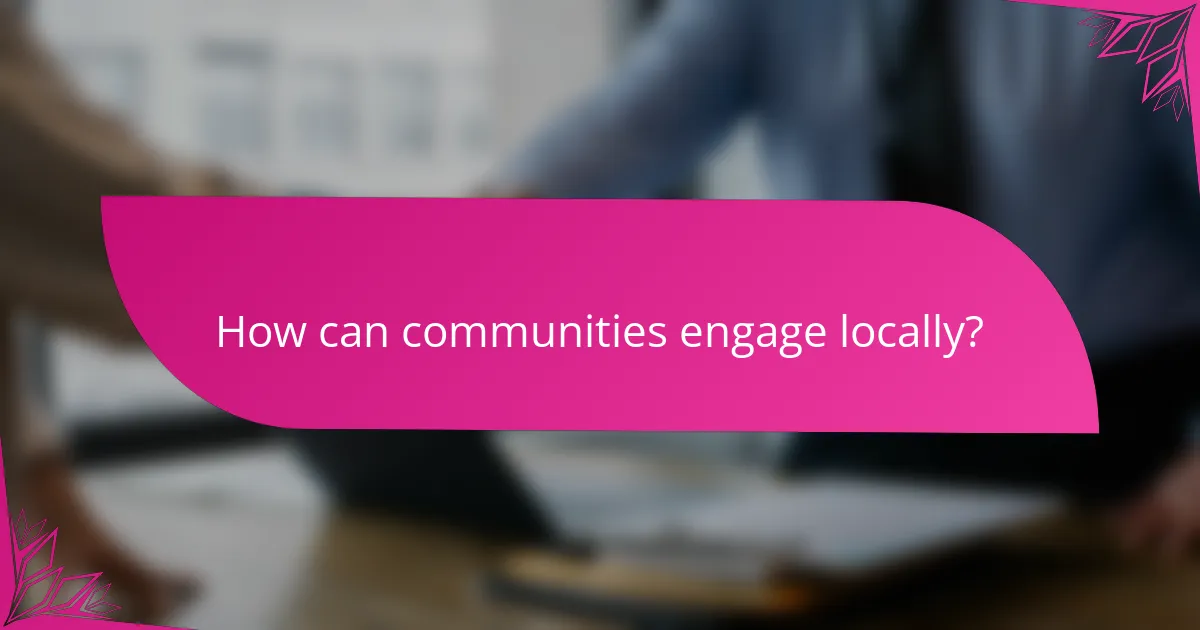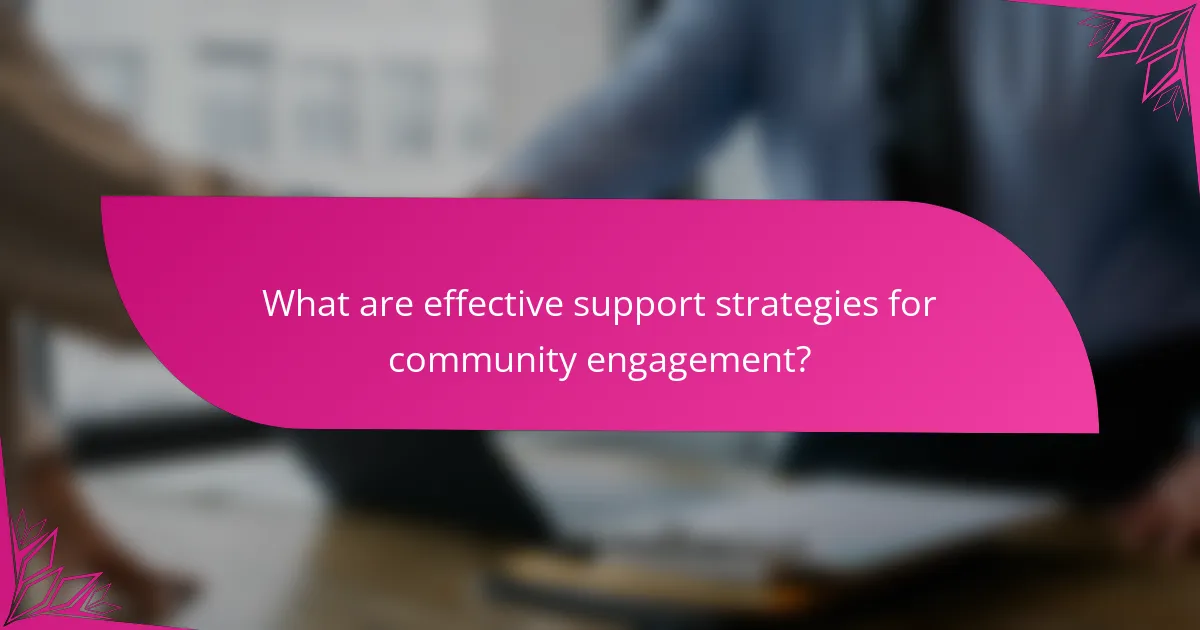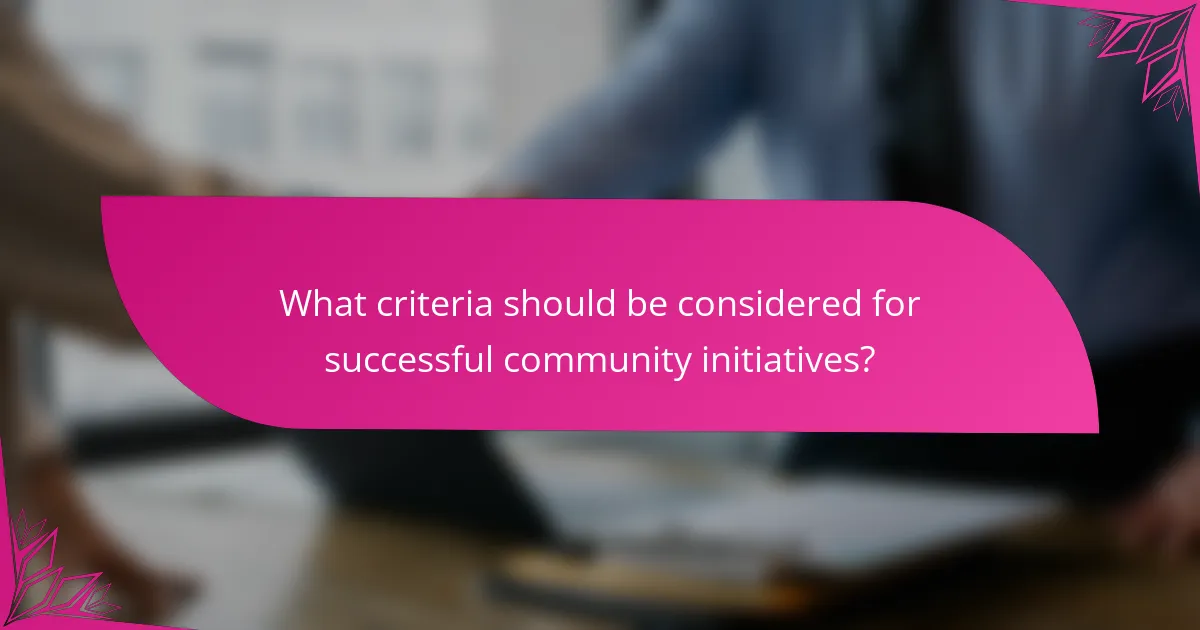Community engagement plays a vital role in strengthening local ties and enhancing overall well-being. By fostering connections among residents and encouraging active participation, communities can create a vibrant environment that supports local initiatives and economic activity. Effective support strategies are essential for building trust and ensuring resources are allocated to maximize impact, ultimately empowering individuals and enriching the community fabric.

How can communities engage locally?
Communities can engage locally by fostering connections among residents and encouraging participation in various activities. This involvement enhances social ties, promotes local initiatives, and strengthens the overall community fabric.
Neighborhood events
Neighborhood events are gatherings that bring residents together to celebrate, learn, and collaborate. Examples include block parties, farmers’ markets, and cultural festivals, which can attract diverse participation and create a sense of belonging.
To organize a successful neighborhood event, consider factors such as location, timing, and activities that cater to different age groups. Engaging local businesses for sponsorship or support can also enhance the event’s appeal and resources.
Volunteer programs
Volunteer programs provide opportunities for residents to contribute their time and skills to local causes. These programs can range from environmental clean-ups to tutoring children, allowing individuals to make a tangible impact in their community.
To start a volunteer program, identify community needs and recruit participants through local schools, churches, or social media. Establish clear goals and provide training to ensure volunteers feel prepared and valued in their roles.
Local partnerships
Local partnerships involve collaboration between community organizations, businesses, and residents to address shared goals. These alliances can enhance resources, increase outreach, and foster a supportive environment for initiatives.
When forming partnerships, focus on aligning objectives and establishing clear communication channels. Regular meetings and joint events can help maintain momentum and strengthen relationships among partners.
Community forums
Community forums are platforms for residents to voice their opinions, share ideas, and discuss local issues. These gatherings can take the form of town hall meetings, workshops, or online discussions, providing a space for open dialogue.
To ensure effective community forums, set a clear agenda and encourage participation from diverse groups. Utilize feedback mechanisms to capture insights and follow up on discussions to demonstrate that community input is valued and acted upon.

What are effective support strategies for community engagement?
Effective support strategies for community engagement focus on fostering participation, building trust, and ensuring resources are appropriately allocated. These strategies can significantly enhance local involvement and create a positive impact on the community.
Resource allocation
Resource allocation involves distributing financial, human, and material resources to support community engagement initiatives. Prioritizing funding for local projects can help address specific community needs, such as youth programs or neighborhood improvements.
Consider creating a budget that includes both direct funding and in-kind contributions, such as volunteer hours or donated materials. Engaging local businesses in sponsorship can also enhance resource availability.
Training workshops
Training workshops are essential for equipping community members with the skills necessary for effective engagement. These workshops can cover topics such as leadership development, conflict resolution, and project management.
Offering workshops regularly, perhaps quarterly, ensures ongoing skill enhancement. Collaborating with local experts or organizations can provide valuable insights and foster a sense of community ownership.
Communication channels
Establishing clear communication channels is crucial for successful community engagement. Utilize a mix of traditional and digital platforms, such as community newsletters, social media, and local meetings, to reach diverse audiences.
Encourage feedback through surveys or suggestion boxes to ensure community members feel heard. Regular updates on projects and initiatives can maintain interest and participation over time.

What impact does local engagement have on communities?
Local engagement significantly enhances community well-being by fostering connections among residents, boosting economic activity, and encouraging active participation in civic matters. These impacts create a more resilient and vibrant environment where individuals feel valued and empowered.
Enhanced social cohesion
Enhanced social cohesion occurs when community members actively engage with one another, leading to stronger relationships and a sense of belonging. This can manifest through neighborhood events, volunteer initiatives, or local clubs that bring people together around shared interests.
For example, organizing community clean-up days not only beautifies the area but also allows residents to bond over a common goal. Such interactions can reduce feelings of isolation and promote a supportive network, which is crucial for community resilience.
Improved local economy
Local engagement can lead to an improved local economy by encouraging residents to support nearby businesses and services. When community members are involved, they are more likely to shop locally, which helps sustain jobs and fosters economic growth.
Initiatives like farmers’ markets or local business fairs can stimulate economic activity by attracting both residents and visitors. These events create opportunities for small businesses to thrive and can increase overall community wealth.
Increased civic participation
Increased civic participation is a direct result of local engagement, as residents become more informed and involved in decision-making processes. When individuals feel connected to their community, they are more likely to vote, attend town hall meetings, or join local advocacy groups.
To encourage civic participation, communities can host informational sessions about local governance or create platforms for residents to voice their opinions. This not only empowers individuals but also ensures that diverse perspectives are considered in community planning and development.

What criteria should be considered for successful community initiatives?
Successful community initiatives require a clear understanding of local needs, active stakeholder participation, and measurable outcomes. These criteria ensure that projects are relevant, supported, and capable of making a meaningful impact.
Community needs assessment
A community needs assessment identifies the specific challenges and opportunities within a locality. This process typically involves surveys, interviews, and focus groups to gather input from residents and local organizations.
Key steps include defining the target population, collecting data on demographics, and analyzing existing resources. For example, a community facing high unemployment may prioritize job training programs based on feedback from local job seekers.
Regular assessments help adapt initiatives to changing community dynamics, ensuring ongoing relevance and effectiveness. Consider conducting assessments every few years or after significant local changes.
Stakeholder involvement
Engaging stakeholders is crucial for the success of community initiatives. Stakeholders include residents, local businesses, government agencies, and non-profit organizations, all of whom can provide valuable insights and support.
Effective strategies for involvement include forming advisory committees, hosting community forums, and utilizing online platforms for feedback. For instance, a local health initiative might invite local clinics and residents to collaborate on health education programs.
It is essential to ensure that all voices are heard, particularly those from underrepresented groups. Regular communication and transparency about decision-making processes can foster trust and encourage sustained engagement.

How do local governments support community engagement?
Local governments support community engagement by providing resources, frameworks, and initiatives that encourage citizen participation in decision-making processes. This support often includes funding, policy development, and creating platforms for dialogue between residents and officials.
Funding opportunities
Local governments often allocate funds to support community engagement initiatives, which can include grants for local projects, events, or programs aimed at fostering civic participation. These funding opportunities can vary widely, with some municipalities offering low thousands to tens of thousands of dollars depending on the project’s scope and impact.
To access these funds, community organizations typically need to submit proposals that outline their objectives, expected outcomes, and budget requirements. It’s crucial to align project goals with the local government’s priorities to increase the chances of receiving financial support.
Policy frameworks
Policy frameworks established by local governments play a vital role in shaping community engagement strategies. These frameworks often include guidelines for public consultations, stakeholder involvement, and transparency in decision-making processes. Effective policies encourage collaboration between government entities and community members, ensuring that diverse voices are heard.
When developing or revising policies, local governments should consider best practices from other regions and engage with community leaders to create inclusive and effective frameworks. Regular reviews and updates of these policies can help maintain relevance and responsiveness to community needs.

What role do nonprofits play in local engagement?
Nonprofits are crucial in fostering local engagement by connecting community members with resources, services, and opportunities for participation. They often serve as facilitators, mobilizing volunteers and advocating for community needs while addressing social issues through targeted programs.
Program implementation
Nonprofits implement programs that directly address local needs, such as education, health services, and environmental initiatives. These programs often rely on community input to ensure they are relevant and effective, which can include surveys, focus groups, or public meetings.
For example, a nonprofit focused on youth development might run after-school programs that provide tutoring and mentorship. By collaborating with local schools and parents, they can tailor their offerings to fit the specific challenges faced by the community.
Advocacy efforts
Advocacy is a key role for nonprofits, as they work to influence policy and raise awareness about local issues. They often engage in lobbying efforts, public campaigns, and partnerships with other organizations to amplify their message and reach a broader audience.
For instance, a nonprofit advocating for affordable housing may organize community forums to educate residents about their rights and mobilize them to contact local representatives. This grassroots approach not only empowers individuals but also creates a collective voice that can lead to meaningful change.


